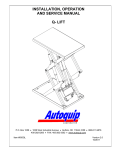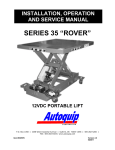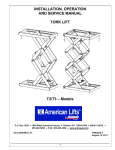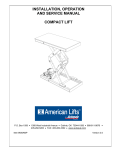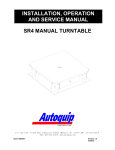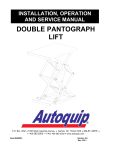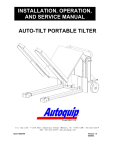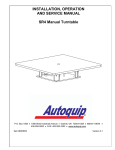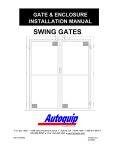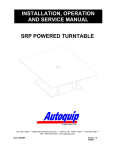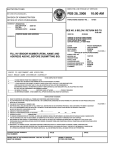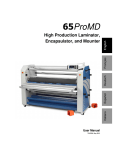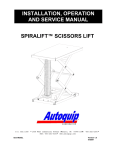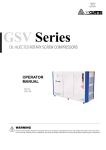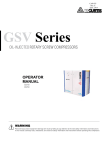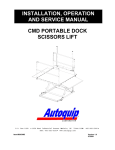Download TORK LIFT - ESS Group
Transcript
INSTALLATION, OPERATION AND SERVICE MANUAL TORK LIFT T1 – Models P.O. Box 1058 1058 West Industrial Avenue Guthrie, OK 73044-1058 888-811-9876 405-282-5200 FAX: 405-282-3302 www.autoquip.com Item #830AMT Version 2.0 April, 2010 TABLE OF CONTENTS Identification and Inspection 3 Responsibility of Owners / Users 4 Safety Signal Words 5 Safety Practices 6 Label Identification 10 Specifications 13 Lift Blocking Instructions 16 Installation Instructions 19 Operating Instructions 24 Routine Maintenance 25 General Maintenance 27 Replacement Parts List 35 Troubleshooting Analysis 38 Warranty 42 IMPORTANT Please read and understand this manual prior to installation or operation of this lift. Failure to do so could lead to property damage and/or serious personal injury. If any questions arise, call a local representative or Autoquip Corporation at 1-888-811-9876 or 405-282-5200. Please record the following information and refer to it when calling your dealer or Autoquip. Model Number:________________Serial Number: ___________________ Installation Date _____/_____/_____ 2 IDENTIFICATION & INSPECTION IDENTIFICATION When ordering parts or requesting information or service on this lift, PLEASE REFER TO THE MODEL AND SERIAL NUMBER. This information is on a nameplate attached to the leg assembly. Replacement parts are available from a local Autoquip distributor. INSPECTION Immediately upon receipt of the lift, a visual inspection should be made to determine that it has not been damaged in transit. Any damage found must be noted on the delivery receipt. In addition to this preliminary inspection, the lift should be carefully inspected for concealed damage. Any concealed damage found that was not noted on the delivery receipt should be reported in writing to the delivering carrier within 48 hours. The following is a checklist that will aid you in the inspection of this lift: 1. Examine entire unit for any signs of mishandling. Pay special attention to the power unit and PUSH BUTTONS. 2. Thoroughly examine all connections, making sure they have not vibrated loose during transit, and inspect wiring for any signs of damage. 3. After installation, raise the lift and inspect the base frame, platform, scissors assembly, and cylinder plumbing connections. PLANNED MAINTENANCE PROGRAM A local Autoquip representative provides a Planned Maintenance Program (PMP) for this equipment using factory-trained personnel. Call a local representative or Autoquip Corporation at 1-888-811-9876 or 405-282-5200 for more information. 3 RESPONSIBILTY OF OWNERS/USERS DEFLECTION It is the responsibility of the user/purchaser to advise the manufacturer where deflection may be critical to the application. INSPECTION & MAINTENANCE The lift shall be inspected and maintained in proper working order in accordance with Autoquip’s operating/maintenance (O&M) manual and with other applicable safe operating practices. REMOVAL FROM SERVICE Any lift not in safe operating condition such as, but not limited to, excessive leakage, missing rollers, pins, or fasteners, any bent or cracked structural members, cut or frayed electric, hydraulic, or pneumatic lines, damaged or malfunctioning controls or safety devices, etc. shall be removed from service until it is repaired to the original manufacturer’s standards. REPAIRS All repairs shall be made by qualified personnel in conformance with Autoquip’s instructions. OPERATORS Only trained personnel and authorized personnel shall be permitted to operate the lift. BEFORE OPERATION Before using the lift, the operator shall have: Read and/or had explained, and understood, the manufacturer’s operating instructions and safety rules. Inspected the lift for proper operation and condition. Any suspect item shall be carefully examined and a determination made by a qualified person as to whether it constitutes a hazard. All items not in conformance with Autoquip’s specification shall be corrected before further use of the lift. DURING OPERATION The lift shall only be used in accordance with Autoquip’s O&M manual. Do not overload the lift. Ensure that all safety devices are operational and in place. Autoquip warrants this lift for 60,000 cycles each warranty year. This number of cycles is meant to represent normal, single shift duty. Exceeding this number of cycles shortens the life of the lift and the length of your warranty and indicates that a more robust lift design for high cycle duty should have been requested. MODIFICATIONS OR ALTERATIONS Modifications or alterations to industrial lifting equipment shall be made only with written permission of Autoquip. Autoquip does not foresee and does not anticipate unauthorized modifications, and these changes or alterations are grounds for voiding all warranties. 4 SAFETY SIGNAL WORDS SAFETY ALERTS (Required Reading!) The following SAFETY ALERTS are intended to create awareness of owners, operators, and maintenance personnel of the potential safety hazards and the steps that must be taken to avoid accidents. These same alerts are inserted throughout this manual to identify specific hazards that may endanger uninformed personnel. Identification of every conceivable hazardous situation is impossible. Therefore, all personnel have the responsibility to diligently exercise safe practices whenever exposed to this equipment. ____________________________________________________________ DANGER! Identifies a hazardous situation, which, if not avoided, will result in death or severe personal injury. _____________________________________________________________ WARNING! Identifies a hazardous situation, which, if not avoided, could result in death or serious personal injury. CAUTION! Identifies a hazardous situation, which, if not avoided, may result in minor or moderate personal injury. _____________________________________________________________ NOTICE! Indicates a potentially hazardous situation, which, if not avoided, may result in property or equipment damage. ____________________________________________________________ 5 SAFETY PRACTICES Read and understand this manual and all labels prior to operating or servicing the scissors lift. All labels are provided in accordance with ANSI Z535.4. DANGER! Do not work under lift without Maintenance Device! To avoid personal injury, NEVER go under the lift platform until the load is removed and the scissors mechanism is securely blocked in the open position. See "Lift Blocking Instructions" section. DANGER! To avoid personal injury, stand clear of scissors mechanism while the lift is in motion. DANGER! Do not install the lift in a pit unless it has a bevel toe guard or other approved toe protection. A shear point can exist which can cause severe injury to the foot. DANGER! HIGH VOLTAGE!! Disconnect and/or lock out the electrical supply to the power unit prior to any maintenance being performed. 6 SAFETY PRACTICES DANGER! Scissors lifts are designed individually for a specific load and application. To avoid personal injury, do not change the load or application from the original design. WARNING! NEVER stand, sit or ride on the lift! WARNING! All warning and information decals should be in place as outlined in the “Label Identification” section. If decals are missing or damaged, they should be replaced with new ones. Contact Autoquip for replacements. WARNING! Do not attempt to remove the velocity fuse until the maintenance block securely supports the lift and all hydraulic pressure has been removed from the lifting cylinders and hydraulic hoses. Failure to do so could results in personal injury or death! WARNING! Lift platforms traveling below floor levels may create openings, and the shape of the load and how the load is arranged on the lift may create a toe hazard as the load passes the top edge of the pit. Both situations may require guarding in accordance with Federal Regulations. Any such guarding must be installed prior to operating the lift. 7 SAFETY PRACTICES WARNING! The hydraulic velocity fuse (HVF) must be properly installed! The HVF is attached to the elbow fitting in the rod port of the cylinder. Do not use a swivel fitting between the HVF and cylinder. If the HVF is installed improperly, it will not lock up in the event of a catastrophic hydraulic line break. WARNING! Use properly rated hoses only! Never use fittings or hoses that are not properly rated for the intended use. WARNING! Never exceed the rated capacity of the lift! Overloading, or uneven loading, could result in load instability and cause serious personal injury. CAUTION! Any time that the velocity fuses have been tripped, owner must investigate the cause of the trip and ensure any necessary corrective actions have been taken prior to resumption of normal lift operation. Failure to do so could result in personal injury or equipment damage. CAUTION! Spilled hydraulic fluid is very slippery, and may also present a fire hazard. Clean up all spilled hydraulic fluid to prevent personal injury or equipment damage. 8 SAFETY PRACTICES NOTICE! Do not continue to depress the “UP” button on the controller if the lift is not raising or if the lift has reached the fully raised position. To do so may result in permanent damage to the motor or pump. NOTICE! Never run the pump for more than a couple of seconds without pumping oil. This applies to low oil conditions, improper motor rotation, running the pump against the relief pressure after the lift is fully raised against the physical stops, running overloaded beyond capacity, or running at reduced speed because of pinched or obstructed hydraulic lines. NOTICE! Do not operate the power unit on relief for more than a few seconds. When on relief, the valve will make a squealing sound. NOTICE! Precautions should be taken to prevent the introduction of contaminates such as dirt or other foreign material into the system through open fittings, pipes or disassembled components. Contamination will ruin the hydraulic system. NOTICE! Use only approved oils in the lift. See “Specifications” section. 9 LABEL IDENTIFICATION 6 5 2 1 4 6 2 5 3 1 Figure 1 Label Placement Tork Lift Item No. 1 2 3 4 5 6 7 Qty 2 4 1 1 2 2 1 Description Caution – Familiarize Yourself With Operators Manual Danger – Do Not Put Hands or Feet . . . Autoquip Serial Number Nameplate Fill with Recommended Oils Only American Lifts by Autoquip Capacity Wire Code Identification 10 Part No. 36401487 36430050 36401560 36400661 36403230 36401586M 36403343 LABEL IDENTIFICATION Note: Labels shown here are not actual size. Figure 3 Label 36401487 Figure 4 Label 36430050 Figure 5 Label 36401560 11 LABEL IDENTIFICATION Figure 6 Label 36400661 Figure 7 Label 36403230 Figure 8 Label 36401586M Figure 9 Label 36403343 12 SPECIFICATIONS Tork Model Capacity (Lbs.) Travel (In.) Lowered Height (In.) Raised Height (In.) Max End Load (Lbs.) Max Side Load (Lbs.) Std Min. Platform (In.) Raise Time (sec) No of Cyl Ship Wt. (Lbs.) T36-022 2200 36 6.5 42.5 1100 1100 24 x 48 40 1 525 T36-044 4400 36 6.5 42.5 2200 2200 24 x 48 32 2 600 T36-060 6000 36 7 43 3000 3000 24 x 48 35 2 650 T1-36-080 8000 36 12 48 4000 4000 48 x 61 43 2 2150 T1-36-100 10000 36 14 50 5000 5000 36 x 64 47 2 2600 T1-36-120 12000 36 14 50 6000 6000 36 x 64 47 2 2800 T1-36-160 16000 36 16 52 8000 8000 36 x 72 39 2 3000 T1-36-300 30000 36 18 54 15000 15000 24 x 80 60 4 3200 T1-48-020 2000 48 8 56 1000 1000 30 x 72 55 1 1200 T1-48-040 4000 48 8 56 2000 2000 30 x 72 40 2 1250 T1-48-060 6000 48 9 57 3000 3000 30 x 72 52 2 1350 T1-48-080 8000 48 13.25 61.25 4000 4000 32 x 80 70 2 3200 T1-48-100 10000 48 15 63 5000 5000 42 x 82 70 2 3600 T1-48-120 12000 48 16 64 6000 6000 42 x 82 70 2 3600 T1-48-160 16000 48 16 64 8000 8000 42 x 82 97 3 3600 T1-48-200 20000 48 16 64 10000 10000 42 x 82 97 3 4400 T1-48-300 30000 48 18 66 15000 15000 44 x 84 46 4 6000 T1-60-025 2500 60 9.75 69.75 1250 1250 50 x 98 40 2 2100 T1-60-040 4000 60 9.75 69.75 2000 2000 48 x 84 40 2 2100 T1-60-060 6000 60 11.75 71.75 3000 3000 56 x 102 80 2 2300 T1-60-090 9000 60 14.5 74.5 4500 4500 56 x 102 80 2 3200 T1-60-120 12000 60 14.5 74.5 6000 6000 56 x 102 80 2 4000 T1-60-160 16000 60 15.5 75.5 8000 8000 64 x 104 80 4 5000 T1-60-200 20000 60 15.5 75.5 10000 10000 64 x 104 80 4 5600 T1-60-300 30000 60 18.5 78.5 15000 15000 64 x 104 75 4 6300 T1-72-020 2000 72 9.75 81.75 1000 1000 48 x 110 64 2 2300 T1-72-040 4000 72 11.25 83.25 2000 2000 48 x 110 45 1 2600 T1-72-060 6000 72 12.75 84.75 3000 3000 48 x 110 80 2 3400 13 SPECIFICATIONS LOAD CAPACITY The load capacity rating is stamped on a metal plate attached to one side of the lift. This figure is a net capacity rating for a lift furnished with the standard platform. The relief valve of the pumping unit has been set to raise the weight, plus a small amount for overload. Where gravity roll-sections, special tops, etc, are installed on the lift after leaving the plant, deduct the weight of these from the load rating to obtain the net capacity. DO NOT EXCEED RATED CAPACITY OF THE LIFT. Loading the lift beyond its rated capacity is unsafe, will shorten the operational life of the lift, and will void its warranty. DANGER! Do not make modifications to the lift without authorization from the manufacturer. Autoquip cannot foresee and is not responsible for injury or damage which results from the unauthorized modifications or misuse of the lift. UNBALANCED LOADING The stabilization provided is basically for balanced loads. If special attachments extend beyond the length and/or width dimensions of the platform, the end and/or side load capacity is reduced 2% for each one-inch extension from the center. If the load is rolling onto the platform (in any but the fully-lowered position) the end and/or side load capacity is reduced by a 50% impact factor (i.e., divide the rated end/side load by 1.50 to establish an available “axle” load). PUMP PRESSURE This lift incorporates a positive displacement pump machined to a high degree of accuracy and specially adapted to requirements of higher-pressure ranges over that of a standard pump. Therefore, standard factory models of the same manufacture cannot replace it. The pump can operate efficiently at intermittent pressures up to 2000 PSI and continuous duty to 1500 PSI. The safety relief valve in the pump assembly is factoryset to stay within the parameters of the pump and lift requirements. 14 SPECIFICATIONS LIFT DUTY Autoquip standard lift designs as described in the specifications typically include intermittent duty motors and are designed to “cycle” (one complete “up” and one complete “down” lift operation) no more frequently than every two minutes – or approximately 60,000 times (cycles) per year. This is considered “normal” duty. It is the responsibility of the user to notify Autoquip whenever a specific application is likely to demand “above normal” duty from the lift - in excess of 60,000 cycles per year. Above normal duty typically requires supplemental design features to enhance the serviceable life of the lift & to avoid loss of warranty. 15 LIFT BLOCKING INSTRUCTIONS WARNING ! Only authorized personnel should perform inspection or maintenance and service procedures. Unauthorized personnel attempting these procedures do so at the risk of personal injury or death. DANGER ! Failure to properly adhere to lift blocking procedures is to risk the sudden and uncontrolled descent of the lift during maintenance or inspection. A falling lift can cause severe injury or death. This procedure describes the only factory-approved method of working under a lift. Follow these instructions EVERY time you plan to reach or crawl beneath the lift to perform service or maintenance – no matter how momentary that might be. If the factory-provided maintenance devices are damaged or missing, stop immediately and consult the factory for assistance. The manufacturer is not liable for your failure to use the approved maintenance devices and procedures that have been provided. 1. All loads must be removed from the lift prior to engaging the maintenance devices. These devices are designed to support an unloaded lift only. Failure to remove the load from the lift prior to blocking could cause the failure of the maintenance devices and allow the lift to fall unexpectedly. This can result in personal injury or death. 2. Raise the lift to its fully raised position. If you do not, the maintenance devices may not be able to be placed properly in their designed blocking position. 3. The lift will be provided with either one (1) maintenance leg stored on one of the scissors arms, or two (2) drop-in maintenance blocks stored on the outside of the base frame. The leg must be placed within the sockets located in both the top and bottom frames. The blocks must be securely placed inside the base frame and thus in the roller path of the lift (See Figure 10). 4. Lower the lift platform either the platform rests securely on the mainteinance leg (inside the socket), or until until the leg rollers make contact with both maintenance blocks. Re-check to ensure that both devices are fully and properly engaged with the leg rollers. If both left and right maintenance locks are not fully engaged the lift could fall unexpectedly. 16 LIFT BLOCKING INSTRUCTIONS Maintenance Leg Socket Maintenance Leg – Engaged Position Maintenance Leg Storage Clips – on top of Inner Leg Fig. 10a. Maintenance Device – (1) Platform Leg Fig. 10b. Maintenance Devices – (2) Roller Blocks Figure 10: Typical Maintenance Devices 17 LIFT BLOCKING INSTRUCTIONS DANGER ! If for any reason you are unable to lower the lift completely onto the maintenance device(s), stop immediately and consult the factory. Failure to properly use the factory approved maintenance device(s) could result in severe injury or death. 5. Once the maintenance devices are properly and securely engaged, continue to press the down button, valve or switch for an additional 5-10 seconds to relieve all pressure in the hydraulic system (it could take longer in a pneumatic system). WARNING ! Failure to relieve operating system pressure could result in the sudden and unexpected release of high-pressure fluids (or air) during maintenance and/or repair of the lift and result in severe injury or death. 6. Follow OSHA electrical lock-out/tag-out procedures. Disconnect and tag all electrical and/or other power sources to prevent an unplanned or unexpected actuation of the lift. 7. Once inspection or work is complete, reverse the performance of the steps above to raise the lift off the maintenance devices and place the devices back into their designated storage positions. DANGER ! HIGH VOLTAGE!! – Disconnect and/or lock out the electrical supply to the power unit per OSHA regulations prior to any installation or maintenance being performed. 18 INSTALLATION INSTRUCTIONS WARNING! Before installing the lift, read & follow the recommended safety practices in the Safety Practices section. Failure to follow these safety practices could result in death or serious injury FLOOR INSTALLATION 1. Make sure the installation area is clean before starting. Check the mounting surface of the floor with a level or straight edge. If the floor is not level, add shims or grout under the lift base frame along the entire perimeter of the base to achieve a level and flat base installation. A level base will ensure proper wheel tracking and smooth lift operation. 2. If the permanent electrical work is not complete, some means of temporary lines with an on-off device for the power supply should be set up for testing purposes. 3. Place the lift in the installation area and level the base frame per note #1. 4. Make temporary electrical connections and permanent hydraulic connections. Raise the lift approximately one foot using the “UP” button. Then lower the lift back to fully collapse, holding the “DOWN” button for approximately 60 seconds. Repeat this process five to seven times to bleed any air out of the hydraulic system. 5. Raise the lift to the top of its travel and make positioning adjustments. Check for the proper height. If needed, shim to the desired height. DO NOT “spot” shim. Shim the full length of the base frame. This will prevent the frame from sagging under an exceptionally heavy load. 6. The base frame of the lift has pre-drilled holes for lagging it securely to the floor. Mark the holes, drill, and install with anchors. Lifts with oversize platforms have minimum pull out requirements of 2,000 lbs. for each anchor. 7. Make permanent electrical connections and operate the lift through a few cycles. NOTICE! Lifts designed to be surface mounted are built with the decks welded on and should not be lifted by the deck or top frame. Doing so may result in damage to the cylinder base mounting straps. 19 INSTALLATION INSTRUCTIONS DANGER! Do not work under the lift without Maintenance Device! To avoid personal injury, NEVER go under the lift platform until the load is removed and the scissors mechanism is securely blocked in the open position and the appropriate OSHA lock-out/tag-out procedure is followed . See "Lift Blocking Instructions" section. PIT INSTALLATION -- MODELS WITH BEVEL TOE GUARDS. DANGER! Do not install the lift in a pit unless it has a bevel toe guard or other approved toe protection. Failure to provide approved toe protection could result in exposure to shear points and potential severe injury to personnel. 1. Check the pit dimensions. Length and width should be 2" minimum longer and wider than the lift platform. Pit depth should allow ½” for shims or grout. 2. Check the case entrance into the pit. The diameter should be 3". If the permanent electrical work is not complete, some means of temporary lines with an on-off device for the motor should be set up for testing purposes. 3. Make sure the installation area is clean before starting. Check the mounting surface of the pit floor with a level or straight edge. If the floor is not level, add shims or grout under the lift base frame along the entire perimeter of the base to achieve a level and flat base installation. A level base will ensure proper wheel tracking and smooth lift operation. 4. Lower the lift into the pit and check for proper height. The lift should be solid and flush with the pit angle framing. If needed, shim to the desired height. DO NOT “spot” shim. Shim the full length of the base frame. This will prevent the frame from sagging under an exceptionally heavy load. 20 INSTALLATION INSTRUCTIONS 5. Make temporary electrical connections and permanent hydraulic connections. Raise the lift approximately one foot using the “UP” button. Then lower the lift back to fully collapse, holding the “DOWN” button for approximately 60 seconds. Repeat this process five to seven times to bleed any air out of the hydraulic system. 6. Raise and lower the lift to make positioning adjustments and align the platform in the pit with a proper clearance of ¾” minimum around the edges from the platform to the pit angle. DANGER! Do not work under lift without Maintenance Device! To avoid personal injury, NEVER go under the lift platform until the load is removed and the scissors mechanism is securely blocked in the open position and the appropriate OSHA lock-out/tag-out procedure is followed. See "Lift Blocking Instructions" section. 7. The base frame of the lift has pre-drilled holes for lagging it securely to the floor. Mark hoes, drill, and install with anchors. Lifts with oversize platforms have minimum pull out requirements of 2,000 lbs. for each anchor. 8. Make the permanent electrical connections and operate the lift through a few cycles. CLEAN UP 1. Clean up any debris from the area. A clean installation makes a good impression and creates a much safer environment! 2. Touch-up paint is available from Autoquip for repair of damaged paint surfaces. WARNING! All DANGER, WARNING, and CAUTION labels and informational decals and plates must be intact and in place on the lift. Contact an Autoquip representative if labels are missing or damaged. See “Label Identification” section of this manual. 3. Clean up any spilled oil from the area. Dispose of and handle used fluid as a hazardous material. 4. Train key personnel on the operation of the lift and all safety features and procedures. 21 INSTALLATION INSTRUCTIONS 1 1 1 1 1/2 Figure 11: Typical Pit Detail 22 INSTALLATION INSTRUCTIONS SHIMMING & ANCHORING LIFT TO CONCRETE (Anchors by Others) Recommended concrete anchor bolts are: HILTI “Kwik-Bolt”, Molly Parabolt or similar. 1. Be sure lift is positioned correctly. 2. Drill holes in concrete the same diameter as anchor bolts, using anchor bracket hole as guides. Depth is not critical – just drill sufficiently deep. 3. With nut and washer on anchor bolts, drive anchor bolts into holes so that a minimum of six to seven threads are below the top surface of the anchor clips. 4. Tighten nuts securely. Be sure enough force is used to spread anchor bolt wedges (usually 3 or 4 turns beyond ‘finger tight’). 5. After lift has been aligned, leveled and shimmed, and anchor bolts have been installed, pour grout under entire base frame. 6. When set and cured, tighten nuts on anchor bolts. 7. Run hydraulic hose or electrical cord through conduit in pit wall. Figure 12: Anchor Detail 23 OPERATING INSTRUCTIONS CAUTION! Familiarize yourself with this operator’s manual before operating this equipment. 1. Scissors lifts have maximum lifting capacity ratings (See the “Specifications” section). The safety relief valve has been factory set to open at a point slightly above the rated load and allows the oil to bypass into the reservoir. The safety relief valve should not be adjusted for any reason as it could cause the motor to prematurely burn out. Applying loads exceeding the rated capacity of the lift may result in excessive wear and damage to the lift. 2. This type of lift is designed primarily for in-plant applications and is furnished with a constant pressure foot switch or PUSH BUTTON controls. Actuating the "UP" button will cause oil to enter the cylinders and the lift will rise. 3. When the desired height or upward travel of the platform is attained, removing the operators’ foot or hand from the switch deactivates the “UP” circuit button. The oil stops flowing and the upward movement will stop. 4. To lower the lift, activate the "DOWN" button. Opening the down control valve allows the oil in the cylinders to flow through the down valve at a controlled rate and return oil to the reservoir. 5. When the desired height or downward travel of the platform is attained, removing the operator’s foot or hand from the switch deactivates the “DOWN” circuit. The oil stops flowing from the cylinders and the downward movement will stop. WARNING ! Personnel should always maintain a safe operating distance of at least 36” any time the lift is operated up or down. NOTICE ! Do not operate the power unit on relief for more than a few seconds. When on relief, the valve will make a squealing sound. 24 ROUTINE MAINTENANCE WARNING! Before maintaining the lift, read & follow the recommended safety practices in the Safety Practices section. Failure to follow these safety practices could result in death or serious injury. Normally scissors lifts will require very little maintenance. However, a routine maintenance program could prevent costly replacement of parts and/or downtime. DANGER! Do not work under the lift without a Maintenance Device! To avoid personal injury, NEVER go under the lift platform until the load is removed and the scissors mechanism is securely blocked in the open position and the appropriate OSHA lockout/tag-out procedure is followed . See "Lift Blocking Instructions" section. Daily Inspection List (10 hours of operation): Check hydraulic reservoir fluid level. Hydraulic pump unit is supplied by others. Check for hydraulic fluid leaks. Check all hydraulic hoses and electrical cords for cracks, abrasions, twisting, etc. Small leaks at connections can be remedied by tightening connections or replacing the faulty component. Check that hydraulic pressure does not exceed 2,000 psi. Check all pivot joints & roller bearings for noise and wear. Check overall condition of unit (i.e. bends, breaks, loose or missing screws, etc.). Monthly Inspection (100 hours of operation): Check quality of hydraulic fluid. Replace if it becomes discolored (oxidized), cloudy, or otherwise contaminated. Factory recommended fluid is SAE 10W-30 oil. DO NOT OVERFILL. Always use clean fluid. Inspect lift cylinder rods for scoring and leaking, wipe away any foreign material. Inspect all structural and mechanical components for cracked, or broken welds and any distortion caused by collision, overloading, or other misuse. Inspect snap rings/bolts at all rollers & pivot points for proper retention & tightness. Inspect keeper bolts which capture cylinder base pins for proper retention. Inspect all ram crosshead roll pins for proper seating & retention. When all above checks have been completed start unit and operate through all functions. Inspect all components for signs of noise, vibration, erratic movement, and any other abnormal behavior. 25 ROUTINE MAINTENANCE Annual Inspection (1000 hours of operation): Change hydraulic fluid and clean reservoir as needed. Always use clean fluid. Never return fluid from drip pans, pit, etc. back to reservoir. Dispose of and handle used fluid as a hazardous material. If noise or vibration has been noticed, remove lift cylinder pins, pivot pins, and roller bearings. Inspect for wear and replace as necessary. Inspect all hydraulic hoses, replace any that show signs of chafing or leaking. Replace all filters. Check for permanent mechanical deformation. OIL REQUIREMENTS Follow the recommendations below that apply to the circumstances most similar to your installation. Environment (Ambient Temperature) Recommended Oil Indoor locations with variable temperatures: 30 - 100 degrees F 5W 30 or 5W 40 Multiviscosity Motor Oil Indoor locations with constant temperatures: 60 - 80 degrees F Permissible to use SAE 20 Motor Oil Outdoor locations: 30 - 120 degrees F 5W 30 or 5W 40 Multiviscosity Motor Oil Outdoor locations: 10 degrees F below 0 to 100 degrees F 5W 20 or 5W 30 Multiviscosity Motor Oil Cold Storage Warehouse: 10 - 40 degrees F Contact local Autoquip Service Rep. NOTE: All oils above are detergent type. OIL CAPACITY Oil capacity varies from one model to the next, between 2 quarts & 5 gallons. NOTICE ! Use approved fluids only! Use of unauthorized fluids may cause damage to seals and hosing. DO NOT USE: Automatic Transmission Fluid (ATF) Hydraulic Jack Oil Hydraulic Fluids Brake Fluids 26 GENERAL MAINTENANCE WARNING! Before maintaining the lift, read & follow the recommended safety practices in the Safety Practices section. Failure to follow these safety practices could result in death or serious injury. CYLINDER REMOVAL AND REPACKING 1. Raise the lift to its full height and block securely. See “Lift Blocking Instructions”. 2. Cut off the electricity to the power unit (lock out-tag out). 3. Disconnect the cylinder hose at the power unit end and insert it into the oil-fill hole of reservoir. 4. Remove the roll pin(s) which are used to connect the cylinder rods to the bushed crosshead mounts on the trunnion pins. 5. Remove the cylinder base & mounting rod from the scissors by unbolting the retaining clips which hold the rod in position. 6. Lift the cylinder out of the leg assembly. 7. Push the piston rod into the cylinder to eject as much oil as possible into a container. 8. Insert a Spanner wrench and turn the upper bearing assembly clockwise until the tip of the retainer appears in the slot. Place a small screwdriver under the retainer and turn it until the retainer is completely removed. 9. Be sure the hose port is open to allow air into the cylinder. Pull the piston rod out to remove the upper bearing. 10. After all of the internal components have been removed, use a bright light to inspect the inner walls of the barrel. Use a cylinder hone to remove any apparent nicks or scratches. Clean and flush the barrel after honing. 11. Remove the piston head nut from the rod. The upper clevis and pin may be used to prevent rotation of the rod while loosening. Remove the old piston. 12. Inspect the groove for nicks or scratches that could affect the seal or barrel walls; remove as necessary. 13. Install the new piston, seals, and rod wiper. 27 GENERAL MAINTENANCE 14. Check the piston head nut for tightness. 15. Liberally lubricate the piston and seal with CLEAN grease or oil. 16. Reinsert the piston into the barrel, taking care not to pinch or nick the new seal. 17. Slip the bearing assembly into place and align the retainer hole with the slot in the barrel. 18. Turn the bearing with the Spanner wrench until the retainer is reinserted completely. 19. Reinstall the end of the cylinder rod into the crosshead mount, realign holes between these two pieces and reinsert roll pin(s) into the hole(s). 20. Bolt the cylinder base rod back into place using the retainer clips. 21. Reconnect the cylinder hose. 22. Check that the lag bolts are secure (when used) after checking all pins and other mechanical and hydraulic connections. 23. Restore the oil level (see oil recommendations in the “Routine Maintenance” section. 24. Turn on the electrical power and press the “UP” button. It may take a few seconds to fill the empty cylinders. Raise the tilter approximately one inch and remove the maintenance block. 25. Lower the lift completely and hold the “DOWN” button for 60 seconds to allow air in the cylinders to bleed back into the tank. 26. Raise the lift to 25 – 50% of its full travel, then lower fully holding the “DOWN” button for an additional 60 seconds. Repeat this step 8 – 10 times. 27. Clean the oil fill breather cap. PIPE THREAD SEALANT Loctite PST #567 pipe thread sealant or equivalent is recommended. Do not use Teflon tape. Tape fragments can cause malfunctioning of the hydraulic system. 28 GENERAL MAINTENANCE BLEEDING AIR FROM THE SYSTEM 1. Bleed any air which may have been entrapped in the hydraulic system by raising the lift to approximately 50% of its full travel, then lower back down completely. Repeat this process five or six times. 2. Raise and block the lift (See “Lift Blocking” section). 3. Remove (bleed) any remaining air which may have trapped in the cylinders by slowly loosening using the bleed screws located on the rod end of the cylinders until air is heard escaping. Tighten bleeder screws back down when clear oil (no bubbles) begins to escape. NOTE: Be extremely careful and loosen screws slowly, the cylinders are under high pressure and could spray oil. 4. Tighten the screw; make sure no oil comes from the screw when it is tightened. 5. Clean up any spilled oil. Used oil should be discarded as it may contain flushed contaminates from the line. VELOCITY FUSE REPLACEMENT DANGER! Do not attempt to remove the velocity fuse until the lift is securely supported with the lift blocking devices and all hydraulic pressure has been removed from the lifting cylinders and hydraulic hoses. Failure to follow these instructions could result in personal injury or death! Never attempt to take a velocity fuse apart and repair it. These are precision devices that are factory assembled under exacting conditions. Velocity fuses should always be replaced. 1. The arrow on the exterior surface of the velocity fuse shows the direction of the restriction to the oil flow. The arrow should always point away from the cylinder. 2. Do not use Teflon tape on the threaded connections of a velocity fuse. Tape fragments can cause malfunctioning of the fuse. 3. Check all fitting connections for hydraulic leaks and tighten as necessary. 29 GENERAL MAINTENANCE HOSE ORIENTATION To prevent damage to the cylinder hose and possible failure of lift, it is necessary to establish a correct hose shape and pattern of movement as follows: 1. Raise the lift to its full height and block securely. See “Lift Blocking Instructions”. 2. Install one end of the new hose to the cylinder elbow fitting. 3. Since the hose is fixed at both ends, it is possible to put a twist in the hose that will allow it to describe the same pattern each time the lift is operated. This twist will allow the hose to travel about half way between the cylinder on the right side and the inner leg on the right side. 4. Lower the lift carefully and check to see that the hose is free and clear of the cylinder and the inner leg assembly. If not, twist the hose in the direction necessary to clear it of any obstruction and then lock the swivel fitting securely. 30 GENERAL MAINTENANCE WIRING AUTOQUIP "SUPER TORQUE' MOTORS Because Autoquip "Super-Torque" motors actually deliver substantially more horsepower than their nameplate rating, they must always be wired for heavier currentdraw than standard motors of the same nameplate rating. However, because of the "Super-Torque" motors starting efficiency and superior running characteristics, circuit components do not have to be as large as for standard motors of equal delivered horsepower. The following chart should be observed in connecting these motors to power sources, remembering that, where 115-Volt operation is contemplated, the currentdraw is too heavy for plugging into ordinary lighting circuits. Heavy wire must be used all the way to the power-source. NOTE: For larger horsepower motors, consult factory. HP and Voltage Full Load Amperages 1/2 HP: 115 V /60 CY/1 PH (36S15) 115 Volts = 15.0 Amps 3/4 HP: 115 V /60 CY/1 PH 115 Volts = 16.6 Amps 3/4 HP: 230 V /60 CY/1 PH 230 Volts = 8.3 Amps 3 HP: 115 / 208 / 230V /60 CY/1PH 5 HP: 230 V /60 CY/1 PH 115 V = 33.6 Amps 208/230V=16.8 Amps 230 Volts = 23.0 Amps 1-1/2 HP: 208 / 230 V /60 CY/3 PH 208 / 230 V= 5.3 Amps 1-1/2 HP: 460 V /60 CY/ 3 PH 460Volts = 2.85 Amps 5 HP: 208 / 230 V /60 CY/3 PH Intermittent Duty Motor 5 HP: 460 V /60 CY/3 PH Intermittent Duty Motor 5 HP: 208 / 230 V /60 CY/3 PH Heavy Duty Motor 5 HP: 460 V /60 CY/3 PH Heavy Duty Motor 208 V=15.8 Amps 230 V=14.8 Amps 460 Volts = 7.4 Amps 208 V=16 Amps 230 V=15.2 Amps 460 V=7.6 Amps MOTOR CONNECTION DIAGRAMS 31 SUCTION LINE FILTER 32 RESERVOIR RELIEF VALVE CHECK VALVE DOWN SOL. VALVE 2 DOWN FLOW CONTROL VALVE 1 HYDRAULIC SCHEMATIC PRESSURE LINE AND DOWN SOLENOID VALVE. PUMP ASSEMBLY PROVIDES COMPLETE THE FUNCTION OF: CHECK, RELIEF, VELOCITY FUSES (QTY. DEPENDS ON MODEL) (1) PER CYLINDER. 2 2 1 1 LIFT CYLINDER(S) (QTY. DEPENDS ON MODEL) GENERAL MAINTENANCE Figure 13: Generic Hydraulic Schematic GENERAL MAINTENANCE Figure 14: Foot Switch Wiring Details – 115VAC/Single Phase Figure 15: Push Button Wiring Details – 115VAC/Single Phase 33 GENERAL MAINTENANCE Figure 16. Generic Electrical Schematic 208-230-460V – 3phase 34 REPLACEMENT PARTS LIST Foot Switch Figure 17. Parts Idenification – Pump Unit 35 REPLACEMENT PARTS LIST 4 3 16 Figure 18. Replacement Parts Diagram – Standard Lift 36 REPLACEMENT PARTS LIST ITEM # 1 2 3 4 5 6 7 8 9 10 11 12 13 14 15 16 17 18 19 20 21 22 23 DESCRIPTION Base Frame Assembly Top Frame and Platform Assembly Inner (lifter) Leg Assembly Outer (stabilizer) Leg Assembly Roller Bearing Assembly Center Axle Pin Assembly Pivot Pin Assembly Cylinder Crosshead Assembly Cylinder Base Pin ASsembly Hydraulic Cylinder Velocity Fuse Flow Control Hydraulic Reservoir Motor Pump Down Solenoid Valve Foot Switch / Pushbutton Control (not shown) Safety Label Kit (not shown) 37 TROUBLESHOOTING ANALYSIS DANGER! To avoid personal injury, NEVER go under the lift platform until the load is removed and the scissors mechanism is securely blocked in the open position. See "Lift Blocking Instructions" section. WARNING! To avoid serious injury or death, GUARDS, INTERLOCKS, and SAFETY DEVICES must be restored to correct operation when installing parts or making repairs. PROBLEM Lift raises, then lowers back slowly. Lift lowers very slowly. POSSIBLE CAUSE AND SOLUTION The "Down" solenoid may not be seating. Remove the solenoid coil and check again. If the lift does not hold with the solenoid coil removed, the down valve cartridge should be removed and cleaned or replaced as necessary. The oil line, hose, or fitting may be leaking. Check and repair if necessary. The “check valve” in the pump assembly may not be seating. This is indicated by the pump shaft and motor turning backward on their own with no power applied. Generally, this condition can be heard. Replace the pump assembly. The down-solenoid is not operating properly due to dirt or damage. Check for pinched tubing or hose. Where pipe is used, check for obstruction in the line. The oil is extremely viscous due to low ambient temperatures. Add or replace with lower weight oil that stays thinner in cold conditions (5W-15, etc.) If foam is visible in tank oil, check for a loose connection in suction line between pump and tank. Tighten connections. 38 TROUBLESHOOTING ANALYSIS PROBLEM Lift does not raise. POSSIBLE CAUSE AND SOLUTION The motor rotation for a 3-phase motor may be reversed. Reverse only two motor electrical leads. Check for a line or hose leak. Check for oil shortage in the reservoir. Add oil as necessary (See Oil Requirements in the “Routine Maintenance” section.) The load may exceed the rating. (See the “Specifications” section.) Remove the excess load. The suction screen may be clogged, starving the pump. Remove and clean the screen. Drain and replace the oil. The suction line may be leaking air due to a loose fitting. Tighten as needed. The breather holes in the reservoir fill plug may be clogged. Remove and clean. The voltage at the motor terminals may be too low to run the pump with the existing load. Check by measuring the voltage at the motor terminals, or as near as possible, while the pump is running under load. Reading the source voltage or pump-idling voltage is meaningless. Inadequate or incorrect wiring can starve the motor when the source voltage is ample. Correct as necessary. The "Down" valve may be energized by faulty wiring or stuck open. Remove the solenoid and check. The motor may be single phasing. Check wiring, fuses, etc. The pump may be seized if motor is humming or blowing fuses on overload protection devices. Remove the pump. The pump should be able to be rotated by hand. Check for cracks in the housing. The down solenoid valve stem may be bent, causing the valve to be stuck open. Replace the down solenoid valve. 39 TROUBLESHOOTING ANALYSIS PROBLEM Lift won’t lower. POSSIBLE CAUSE AND SOLUTION The solenoid coil may be incorrectly wired, burned out, not rated for the voltage, or the line voltage may be excessively low. Check voltage near the coil. The velocity fuse may be locked. Do not attempt to remove the velocity fuse. The following steps should be followed: 1. Remove the load from the lift. Inspect all fittings, hoses, and other hydraulic components for leads or damage. 2. If no leak or damage is noticed, attempt to pressurize the lifting cylinder by depressing the “UP” button on the controller for a few seconds. Immediately up releasing the “UP” button, depress the “DOWN” button. If the lift starts to lower, continue pressing the “DOWN” button until the lift is in the fully lowered position. 3. If the lift does not lower after trying Step 2, wait approximately 10 – 15 minutes for the pressure in the hydraulic system to equalize. Then, depress the “DOWN” button until the lift is in the fully lowered position. 4. Once the lift is in the fully lowered position, bleed the air from the hydraulic system by depressing the “DOWN” button. Hold the “DOWN” button for approximately 60 seconds. This step may need to be repeated several times to fully remove the air in the system by raising the lift to 50% of its travel and lowering. Should the above steps not correct the problem, contact Autoquip to obtain instruction for further action. 40 TROUBLESHOOTING ANALYSIS PROBLEM Lift seems bouncy during operation. Motor labors or heats excessively. POSSIBLE CAUSE AND SOLUTION Lower the lift to collapsed position and continue to hold “DOWN” button an additional 10-30 seconds to bleed air from the cylinder. Do not confuse spongy or jerky operation with small surges that may occur when operating on rough or uneven floors Check for oil starvation. The voltage may be low. Check at the motor terminals while the pump is running loaded, not at the line source or while the pump is idling. Inadequate wiring can starve the motor even when the source voltage is ample. Most of Autoquip’s standard motors are rated for intermittent duty (two minute run times with two minute rests). If a single-phase motor is being run more than 15 – 20 motor starts per hour, or a 3phase motor more than 200 starts per hour, the problem may be motor over-heating. Running against relief pressure unnecessarily due to over loaded lift or hitting physical stops. Failure to observe wiring diagram on nameplate for proper voltage connections. The pump may be binding from oil starvation, which develops high internal heat. Check for low oil level or closed breather holes in the reservoir fill plug. The pump can be irreparably damaged by oil starvation and may have to be replaced. 41 LIMITED WARRANTY The user is solely responsible for using this equipment in a safe manner and observing all of the safety guidelines provided in the Operation Manual and on the warning labels provided with the lift. If you are unable to locate either the manual or the warning labels, please contact Autoquip or access www.autoquip.com for replacement downloads or information. Autoquip Corporation expressly warrants that this product will be free from defects in material and workmanship under normal, intended use for a period of Two (2) Years for all electrical, mechanical, and hydraulic components, parts or devices, and warrants the structure of the lift against breakage or failure for a period of Five (5) years. The warranty period begins from the date of shipment. When making a claim, immediately send your dealer or Autoquip notice of your claim. All claims must be received by Autoquip within the warranty time period. The maximum liability of Autoquip, under this Limited Warranty, is limited to the replacement of the equipment. This warranty shall not apply to any Autoquip lift or parts of Autoquip lift that have been damaged or broken in transit/shipping, or due directly or indirectly to misuse, abuse, vehicle impact, negligence, faulty installation, fire, floods, acts of God, accidents, or that have been used in a manner contrary to the manufacturer’s limitations or recommendations as stated in the manual, or that have been repaired, altered or modified in any manner outside of Autoquip Corp’s manufacturing facility or which have not been expressly authorized by Autoquip. Autoquip Corporation makes no warranty or representation with respect to the compliance of any equipment with state or local safety or product standard codes, and any failure to comply with such codes shall not be considered a defect of material or workmanship under this warranty. Autoquip Corporation shall not be liable for any direct or consequential damages resulting from such noncompliance. Autoquip Corporation’s obligation under this warranty is limited to the replacement or repair of defective components at its factory or another location at Autoquip Corp’s discretion at no cost to the owner. This is owner’s sole remedy. Replacement parts will be warranted for the remainder of the equipment warranty period or ninety (90) days, whichever is longer. Except as stated herein, Autoquip Corporation will not be liable for any loss, injury, or damage to persons or property, nor for direct, indirect, or consequential damage of any kind, resulting from failure or defective operation of said equipment. All parts used to replace defective material must be genuine Autoquip parts in order to be covered by this Limited Warranty. . AUTOQUIP CORP P.O. Box 1058, Guthrie, OK 73044-1058 Telephone: (888) 811-9876 · (405) 282-5200 Fax: (405) 282-3302 www.autoquip.com 42










































